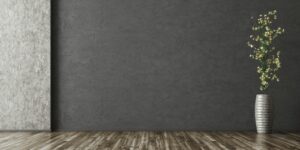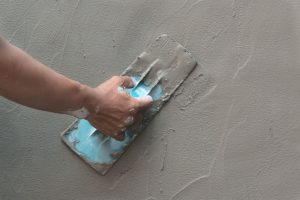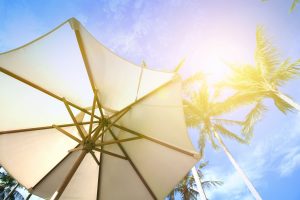Although you might not know what it is, you have probably seen stucco before. It is often used as a finish on houses and buildings and has a natural, textured style. With different colors and uses, you can use stucco in the interior or exterior of a building to add an extra design element. In this article, we will discuss some commonly-asked questions about stucco, including what is it, what it is made of and where it works best.
Indoor And Outdoor Use Of Stucco
 Stucco is a finish that is used on walls and surfaces to give it a desired color and texture. It is tough and can be used for interior and exterior surfaces. You can choose to put stucco over a finished outdoor grilling station, on the exterior of a house or even on the base of a kitchen island. However, the stucco that you use for exterior applications is not the same as the kind for interior use.
Stucco is a finish that is used on walls and surfaces to give it a desired color and texture. It is tough and can be used for interior and exterior surfaces. You can choose to put stucco over a finished outdoor grilling station, on the exterior of a house or even on the base of a kitchen island. However, the stucco that you use for exterior applications is not the same as the kind for interior use.
Stucco that is used for the exterior of a house or building is made to withstand rays from the sun beating down on it throughout the day and inclement weather conditions. When used on wood, paper is placed on the wood before the stucco is applied to keep the wood from water damage.
What Is Stucco Exactly?
Stucco is a cement-based siding that adds a textured finish to a wall. It is made from a mixture of cement, sand, water and lime. It can come in a variety of colors and textures and comes in two types of stucco systems. These are known as the 3-coat system and the 1-coat system.
1 Coat v 3 Coat
The two systems of stucco are the 1- and 3-coat systems. These vary slightly in how they are made and what they are used for. The 3-coat system is usually made with plastic cement, which comes with the lime mixed in, and is known for its strength.
The 3-coat system has a base coat that is made from cement, sand and water. However, it also contains pieces of fiberglass and acrylic additives to make it stronger and water-resistant. The finishing coat can be an acrylic or cement finish that goes over the base coat, which is also true of 1-coat systems.
Choosing A Finish
 There are two different kinds of finishes that you could use for the final coat of stucco. These are acrylic or cement finishes. Both can be used in interior and exterior space and can have color added, but the acrylic option has a brighter color finish.
There are two different kinds of finishes that you could use for the final coat of stucco. These are acrylic or cement finishes. Both can be used in interior and exterior space and can have color added, but the acrylic option has a brighter color finish.
Cement
If you choose a cement finish then you will mix cement with sand and water and before adding color into the mix. You can use a color chart to pick the shade you want, or you could have a custom color made.
Acrylic
An acrylic finish is made in a similar way, but has pieces of crushed stones in the mix to add texture. You can color this finish the same way as a cement finish, but acrylic stucco colors are brighter and more vibrant.
Examples Of Stucco
Although there are two basic kinds of finishes, the texture and look of the finish can vary. There are multiple finishes that give added texture to the building and come with a unique style that can be matched to the contemporary or traditional look you are wanting. Here are two of the most popular options.
Dash Finish
This finish is sprayed on and has lots of texture with many smaller pieces of stone or aggregate mixed in. This offers a rough and heavily textured finish that works great for providing a unique exterior.
Sand Finish
This finish is similar in style to the dash finish but is much easier to apply. This finish has aggregate pieces inside the finish that adds a small amount of texture to a building. It can be very fine, with the pieces protruding only slightly from the wall, or with pieces that stick out farther to look like clumps of sand.
Best Climate For Stucco
 Stucco is durable and is great for both hot or cold climates, but if you live in an area that gets heavy rain or frequent snowstorms, it may not be the best choice. Heavy rain, snow, or hail can damage the outside of the stucco, but the biggest issue is the absorption of water. When it rains, or when the snow melts, it can be absorbed into the stucco and cause a pocket of moisture behind the surface.
Stucco is durable and is great for both hot or cold climates, but if you live in an area that gets heavy rain or frequent snowstorms, it may not be the best choice. Heavy rain, snow, or hail can damage the outside of the stucco, but the biggest issue is the absorption of water. When it rains, or when the snow melts, it can be absorbed into the stucco and cause a pocket of moisture behind the surface.
So, although stucco can withstand hot or cold temperatures, you do not want it to use it in wet climates. Areas that have high humidity or consistent rain throughout the year will cause your stucco to not last as long as it could in dry climates. Other siding options will be better for wetter climates.
Schedule An Appointment With Waterproof Caulking & Restoration
Stucco can be a great option for the interior or exterior of your building, and its strength and durability can prevent damage to your walls. It will also give your building a nice, sleek finish. If you are ready to have stucco installed on your building, call Waterproof Caulking and Restoration today at (484) 265- 9646 or schedule an appointment online and have an expert get the job done fast!
